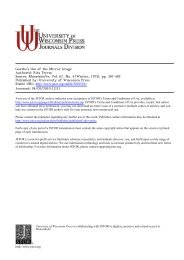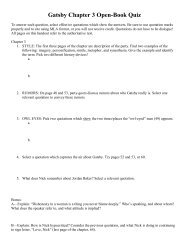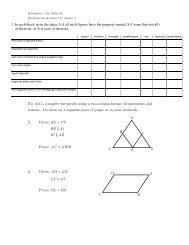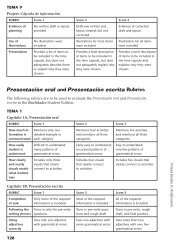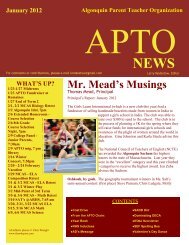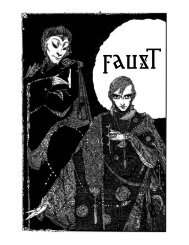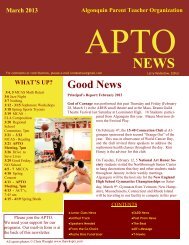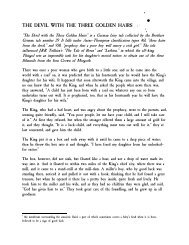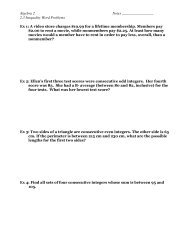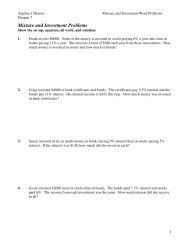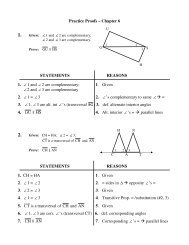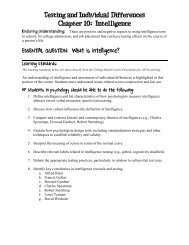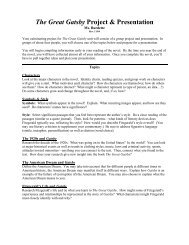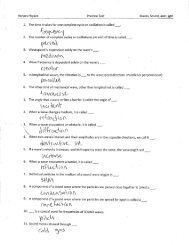My Fair Lady Study Guide
My Fair Lady Study Guide
My Fair Lady Study Guide
- No tags were found...
You also want an ePaper? Increase the reach of your titles
YUMPU automatically turns print PDFs into web optimized ePapers that Google loves.
Chicago PlaybillOne of the most well-known names in the smaller-scale musical world is NewYork City Center’s Encores! Great American Musicals in Concert. Since 1994, theEncores! series has produced concert versions of major American musicals, oftenshows that have been forgotten by musical theater audiences. The purpose of theseries is to celebrate and show off the scores of these shows—scenery andcostumes are kept to a minimum, and actors perform with scripts in their hands.The current Broadway production of Chicago (on which the film version wasbased) originated as an Encores! production. A similar program—Reprise!—carries out the same mission in Los Angeles.From the Encores! production of Purlie8
Sweeney ToddSometimes a smaller-scale version of a musical serves to spotlight a classic score.In the case of the current Broadway production of Stephen Sondheim’s SweeneyTodd however, the production’s intent is to reexamine the haunting musical andreinvent it with a brand new concept. Director John Doyle strips away realisticsets, places all of his props (and actors) onstage throughout the show, andreplaces the orchestra with the actors themselves—renowned Broadway actorPatti Lupone, for example, plays the xylophone, triangle, and tuba at variouspoints in the piece. The result is both a radical rethinking of Sondheim’s themesand original intentions and an unqualified artistic and economic success.Sweeney ToddThe two piano version of <strong>My</strong> <strong>Fair</strong> <strong>Lady</strong> provides new ways of looking at andthinking about the venerable musical. Thanks in part to the immensely popular1964 film, <strong>My</strong> <strong>Fair</strong> <strong>Lady</strong> is often remembered as much for big dance sequencesand flashy Victorian Era fashion as for its classic score and story. Dehnert’sproduction turns its focus onto the show’s essential artistic parts by exploringwhat makes the piece uniquely theatrical and intimate. The production bothcelebrates the original music and investigates in new ways the themes of thistimeless American classic.9
nearly as bad shape as they were made out to be—and he would prove to becorrect. By the early Edwardian era, the working class was making greateconomic, social, and health strides, with the help of, among other factors:Improved sanitation techniques and practices.Mass education.Increased charitable interest from the wealthy.Developing public welfare services.More readily and consistently available employment opportunities.Horse-drawn and motor vehicles share the streets ofEdwardian Era London..Edwardian Era London men.A London tenement street.13
ROLE OF WOMEN: SOCIETY AND SUFFRAGEThroughout the mid-nineteenth century, the wealthy inhabitants of greaterLondon – the twenty percent of the population living above the poverty line -developed the concept of society: a cultural and economic elite known largely forstyle, fashion, and extravagant parties. In addition, members of society adheredto certain unalterable social principles, including:Hierarchy: The members of society existed at the very top of the classsystem (or just under the monarchy); the poor of the inner city weredeemed to be of a lower social class;Respectability: It was the duty of a member of society to appearrespectable to outsiders at all times; this included dress, speech, manners,and behavior;Male dominance: The men in society were breadwinners and societalleaders.This is not to say that women were completely unvalued within society.Although Upper and Middle Class women were not members of the work force,they often took on the role of gatekeeper within society – making sure that therich stayed within the proper boundaries and the poor stayed away entirely.Regardless of economic status, women had few rights in the United Kingdom(UK). The Women’s Social and Political Union (WSPU) was formed in 1903 inorder to fight this unfair discrimination and work towards lasting social reform.One of the key components of the WSPU’s mission was the campaign forwomen’s suffrage – the right to vote. Over the course of the next fifteen years,the “Suffragettes”, as they came to be known, went to great lengths to make theirvoices heard: from five hundred thousand person rallies in London’s Hyde Parkto coordinated window-smashing raids throughout the city’s high fashion, highsociety shopping neighborhoods. In 1918, the efforts of the WSPU (and othersocial reformers) were rewarded, as UK women over the age of 30 were given theright to vote. In 1928, women were given the exact same voting rights as men.14
CLASSA social class system is defined as the ranking of the members of aculture into some sort of artificial order of value.In a social class system, the members of a culture are divided into imaginarygroups (or classes) which are then placed into a hierarchy (a series in which eachelement is graded or ranked). Groups that are believed to have the most powerin that culture are placed at the top of the hierarchy, while groups with little orno power are placed at the bottom.There have been many different types of class systems throughout history. Aclass system can contain any number of groups, and these groups can be dividedin any number of ways. Classes are often formed around socioeconomic lines(how much money a person has), but class can also be defined by other factors:education, race, occupation, ownership of land or other property, or politicalstanding.15
SOME EXAMPLES OF CLASS SYSTEMSThe Two Class SystemThe most basic (and sometimes oversimplified) of the class systems, made up of:An Upper Class, consisting of the rich and/or powerful,A Lower Class, consisting of the poor and/or weak.In a two class view of slavery, for example, the Upper Class was made up of theslave-owners, while the slaves formed the Lower Class. In Marxism, thecapitalists (people who own businesses) make up the Upper Class and controlthe lives of the proletariat or Working Class (people who work in the businesses).The Four Class SystemThis system is particularly relevant to the time period in which <strong>My</strong> <strong>Fair</strong> <strong>Lady</strong>takes place. With new machines and technologies being constantly developed,safety was often a key concern for people who worked for a living. As a result,the level of danger people faced on their jobs became an important classdistinction, and society could be said to be divided like this:Upper Class – the cultural elite, who live off of their investments and donot have to work at all,Upper Middle Class – workers who are employed in safe, clean jobs,Lower Middle Class – workers who are employed in dangerous jobs withunsanitary working conditions,Lower Class – citizens who either do not work or do not make enoughmoney to enjoy any economic freedom.In The Four Class System, the distinction between Upper Middle Class andLower Middle Class IS NOT how much money a person makes (although thesafer, cleaner jobs often did pay more), but how safe and healthy a person’s workenvironment was.The Nine Class SystemIn his book Class: A <strong>Guide</strong> Through the American Status System, historian PaulFussell presents his theory of a nine class structure to describe contemporaryAmerican society:Top out-of-sight: The incredibly wealthy -- for example, Bill Gates(estimated to be worth more than 50 billion dollars) or the Walton Family(who own Walmart and are estimated to be worth a combined 150 billiondollars),Upper Class: Rich actors, athletes and other celebrities who haveextravagant wealth and are constantly in the public eye (Lebron James,Angelina Jolie, and Jay-Z fall into this group),Upper-Middle Class: Well-educated professionals who have made theirown money (not inherited it from rich parents),16
Middle Class: Office workers (who are financially stable and work in safedesk jobs),High Prole: Workers who work with their hands in jobs that require acertain amount of training and skills (carpenters and plumbers, forexample). The term “prole” is short for proletariat.Mid Prole: Workers in factories and the service industry; these jobs areoften more dangerous and offer less money and security,Low Prole: Manual Laborers who, for example, work on farms they do notown; these jobs can be extremely dangerous and tiring and often do noteven pay minimum wage,Destitute: The homeless and jobless who have no income,Bottom out-of-sight: Prisoners and anyone who is incarcerated in any typeof institution.EXERCISES AND QUESTIONS1. Class & Oppression:To answer the following questions refer to the Cast of Characters from <strong>My</strong><strong>Fair</strong> <strong>Lady</strong> listed on page 5 and the “Four Class System” listed above.o Which class does each character belong to?o What role does each of the female characters play in London society?o How do the men in the play view the women?o How is each of the characters in the musical oppressed by someone ina higher social position?o Are there any characters who are not in any way oppressed? Explain.o Are there any characters who do not oppress any other characters inany way? Why do you think this is?2. Suffrage:To answer the following questions refer to the section “Role of Women:Society and Suffrage” on page 11 as well as the following websites:- library.thinkquest.org/J002886/sufferage.html- www.ibiblio.org/unipress/ncbooks/suffrage/sufferage.html- Google: suffrageo Examine the specific ways the suffrage movements chose to resistoppression.o Create a time line of the suffrage movement in the United States.o Create a time line of the suffrage movement in the United Kingdom.o Compare the two time lines. What, if any, conclusions can be drawn?o How do you think Eliza would react to the suffrage movement at thebeginning of the play?o How do you think Eliza would react to the suffrage movement onceshe has become a new woman and potential member of high society?17
LANGUAGE“A woman who utters such depressing and disgusting noises has no right to beanywhere—no right to live.” – Henry Higgins, Act One, Scene One“An Englishman’s way of speaking absolutely classifies him. The moment hetalks he makes some other Englishman despise him.”– from “Why Can’t The English?”As a professor of phonetics (in his words, “the science of speech”), HenryHiggins believes that the way a person speaks is the most important factor inestablishing his or her social class. He believes that there is a perfect, properapproach to the English language, and that a failure to understand and masterthat approach prevents a citizen from becoming a success. Eliza Doolittle, on theother hand, speaks in the language of the London streets. She is unconcernedwith her pronunciation and grammar; as a poor flower girl supporting her harddrinkingfather, she has more immediate issues to worry about.So who is right?ACCENTS AND DIALECTSThe word ACCENT can be defined as:A characteristic pronunciation, especially:a. One determined by the regional or social background of the speaker.b. One determined by the phonetic habits of the speaker's native language carriedover to his or her use of another language.In other words, an accent is the specific way a person pronounces specific words.That pronunciation can be shaped by where the person lives or grew up, theperson’s original (or native) language, or any number of social factors.The word DIALECT can be defined as:A regional or social variety of a language distinguished by pronunciation, grammar, orvocabulary, especially a variety of speech differing from the standard literary language orspeech pattern of the culture in which it exists.A dialect, then, applies not only to the way a person pronounces specific words,but also which words a person uses and how the person uses those words to18
convey his or her meaning. A dialect often will use words in very different waysthan the “proper” or widely accepted usage of the language it comes from.Do you speak a dialect?Do you have the same dialect as the rest of your immediate family?Siblings? Parents? Grandparents?Do you have the same dialect as your classmates? Teachers?Do you have the same dialect as your friends or family in otherneighborhoods?Do you have the same dialect as your friends or family in different cities?Site examples of specific words you use or pronounce differently thanother people you know.What creates the difference in these dialects? Age? Location? Race?ACCENTS AND DIALECTS IN MY FAIR LADYIn <strong>My</strong> <strong>Fair</strong> <strong>Lady</strong>, Henry Higgins speaks Standard English – the “proper” orwidely accepted form of English within the United Kingdom. He enunciates hiswords clearly, making each sound easy to understand. Even when he isinsulting someone, he chooses his words carefully (often selecting phrases thathighlight his advanced education), as this quotation illustrates:“Yes, you squashed cabbage leaf, you disgrace to the noble architecture of thesecolumns, you incarnate insult to the English language; I could pass you off as theQueen of Sheba.”What does Henry’s dialect say about his personality? His values? Hisbackground? His economic status?How do other characters react to Henry’s dialect? What does Eliza thinkof the way Henry speaks? What does Pickering think?Rewrite Henry’s quotation from above in your own dialect.Eliza, on the other hand, speaks the Cockney dialect of English – one of thetraditional dialects of London’s poor working class. Cockney is known for itsdistinctive pronunciations and word choices, some of which can be seen here:“Aoooow! I ain’t dirty: I washed my face and hands afore I come, I did.”Eliza uses the word “ain’t” instead of “I am not”, “afore” instead of “before”, and“I come” instead of “I came”. She adds the phrase “I did” to the end of hersentence for extra emphasis. She makes the unusual “Aoooow” sound (which19
particularly drives Henry crazy) to express her anger and displeasure. All ofthese word choices stem from her upbringing in the Cockney dialect.What does Eliza’s dialect say about her personality? Her values? Herbackground? Her economic status?How do other characters react to Eliza’s dialect? What does Mrs. Pearcethink of the way Eliza speaks? What do her father and his friends think?Rewrite Eliza’s quotation from above in your own dialect.STANDARD ENGLISH: HOW “STANDARD” IS IT?As previously mentioned, Henry’s Standard English is often viewed as theproper or correct approach to pronunciation and grammar in the UnitedKingdom. Standard English is taught in schools and spoken by important publicfigures in the government and media. However, most UK citizens speak with anaccent specific to the region in which they live—not any national standard. MostUK citizens do not follow Standard English rules of grammar and vocabulary; aslittle as twelve to fifteen percent of the population adheres to this “standard”.Use the Cast of Characters from <strong>My</strong> <strong>Fair</strong> <strong>Lady</strong> listed on page 5 and put an“S” next to the name of each who speaks Standard English.Use the Cast of Characters from <strong>My</strong> <strong>Fair</strong> <strong>Lady</strong> listed on page 5 and put an“R” next to the name of each who speaks with a regional dialect.In <strong>My</strong> <strong>Fair</strong> <strong>Lady</strong>, do all of the characters at the top of the social hierarchyspeak Standard English?Do all of the characters who are lower in the hierarchy speak withregional dialects?If not, can you give reasons to explain why not?WHY ARE THERE SO MANY DIFFERENT ENGLISHES?Eliza and Henry both live in London, and they both speak English, but theirdialects vary greatly. Both of their dialects are very different than yourCleveland dialect, which may be very different than that of a friend or familymember from New York, Boston, or Dallas. How can so many people speak thesame language in so many different ways?All languages are constantly evolving. As people use language in their everydaylives, they add to or change existing rules of pronunciation, grammar, andvocabulary. When one group of people who speak a language live far away20
from other people who speak that language, it is likely that these new rules willnot all be shared among all groups. If you and your friends invent a new slangword, teenagers in San Francisco will not automatically understand that newword’s meaning. You have adapted the English language according to your ownlocal dialect.If all languages are always changing, then why would a linguistic scholar such asHenry Higgins be so resistant to dialects such as Cockney? Why would he fightso hard against change?THE ARGUMENT AGAINST LINGUISTIC CHANGEBritish linguistic scholar and dialect expert Peter Trudgill suggests thatobjections to language change are often “presumably really objections to whatthe objectors perceive to be symbolic of a threat to their culture and way of life.”Restate Trudgill’s theory in your own words. What is he saying about theattitudes of people who are resistant to linguistic change?In <strong>My</strong> <strong>Fair</strong> <strong>Lady</strong> does Henry Higgins perceive dialects as a potential threatto his way of life? If so, in what ways? Find evidence in the script thatsupports your answer.Have you ever stereotyped or judged another person simply on their useof language? Have you ever been stereotyped or judged by the samestandard?Could Trudgill’s theory of “objections to language change” be used by thehigher classes to discriminate against or oppress the lower classes?List some ways that language can be utilized to maintain the class systemand prevent shifts in political, economic, and/or social power.List some ways that language can be utilized to break the class system andcause shifts in political, economic, and/or social power.21
Activity SheetCharacter ObjectiveCharacters in movies, plays, books, and stories have a basic similarity.They all have OBJECTIVES.An objective is: SOMETHING A CHARACTER WANTS, NEEDS ORDESIRES throughout the story. They usually spend the entire timepursuing this objective.Each character in “<strong>My</strong> <strong>Fair</strong> <strong>Lady</strong>” has an OBJECTIVE as well. What is theprimary desire of the following characters?Eliza Doolittle:Henry Higgins:Colonel Pickering:Freddy Eynsford-Hill:Alfred P. Doolittle:Mrs. Pearce:Mrs. Higgins:Professor Zoltan Karparthy:22
Activity SheetThemeEvery play has a THEME. Every book and movie does, too.Theme: the main idea or ethical precept of the play.Theme is the same as topic, subject matter, premise or thesis.<strong>My</strong> <strong>Fair</strong> <strong>Lady</strong> focuses on the theme of TRANSFORMATION.List three examples of how the theme of transformation is illustratedin the plot of <strong>My</strong> <strong>Fair</strong> <strong>Lady</strong>. Be very specific.1. ________________________________________________________________________________________________________________________________________________________________________2. ________________________________________________________________________________________________________________________________________________________________________3. ________________________________________________________________________________________________________________________________________________________________________Do these examples connect to the objectives of the characters?Think about your favorite movie or book. Answer the following questions:Title: __________________________________________________________What is the theme: _______________________________________________List examples of how the theme is illustrated:1. _________________________________________________________________________________________________________________________________________________________________________________2. _________________________________________________________________________________________________________________________________________________________________________________3. _________________________________________________________________________________________________________________________________________________________________________________Discussion question: What would happen if a story had no theme?23
Activity SheetA Good PlotPlot: what happens in a play; the story/stories being told as revealed by whatthe characters say about themselves or each other; the action of the play.Here are sixteen plot points from the script of <strong>My</strong> <strong>Fair</strong> <strong>Lady</strong>.Put them in the order they take place in the scriptby placing a number (1 to 16) in the space at the left._____ Eliza finally “gets it”._____ Higgins realizes he has deep feelings for Eliza._____ Eliza is a success and her feelings are hurt._____ Eliza asks Higgins for lessons._____ Higgins and Pickering make the bet._____ Higgins meets Pickering and Eliza outside Covent Garden._____ Freddie comes to visit Eliza._____ Eliza is presented at the Embassy Ball._____ Higgins works Eliza very hard._____ Eliza returns to Higgins._____ Freddy tells Eliza he is in love with her._____ Eliza’s father finds out she is living with Higgins._____ Eliza is tried out at the Ascot Races._____ Eliza is not recognized by her old friends._____ Eliza’s father takes money from Higgins._____ Eliza leaves Higgins.A good plot… keeps you guessing.A good plot… surprises you.A good plot… will have multiple themes.A good plot… builds on a strong central conflict.24
Activity SheetCharacter & RelationshipThe central character in <strong>My</strong> <strong>Fair</strong> <strong>Lady</strong> is Eliza, as everything revolvesaround the relationship of the other characters to her.For each character listed below, define that relationship and how eachcharacter “transforms” because of Eliza’s growth and change.Henry Higgins: _______________________________________________________________________________________________________________________________________________________________________________________________________________________________________Colonel Pickering: ____________________________________________________________________________________________________________________________________________________________________________________________________________________________________Freddy Eynsford-Hill: _________________________________________________________________________________________________________________________________________________________________________________________________________________________________Alfred P. Doolittle: ____________________________________________________________________________________________________________________________________________________________________________________________________________________________________Mrs. Pearce: _________________________________________________________________________________________________________________________________________________________________________________________________________________________________________Mrs. Higgins: ________________________________________________________________________________________________________________________________________________________________________________________________________________________________________25
Activity SheetCockney Rhyming SlangPerhaps the most infamous of all the British slang, Cockney Rhyming Slang isa richly complicated, in-the-know type of language. It is said that slang wasoriginally developed by the thieves of London, so that they could communicatewithout the bobbies (police) understanding what they were saying.In Cockney Rhyming Slang, a word is represented by a phrase that ends in a rhyme.For example, the word mate rhymes with china plate.So the phrase china plate represents mate.However, in spoken slang, only the beginning of the phrase would remain.So the word china means mate.Here are some other examples of Cockney Rhyming Slang.Use the slang terms in a sentence as illustrated in example #1.1. Adam and Eve = believeSentence: Would you Adam and Eve it?2. Apples and Pears = stairsSentence: ___________________________________________________________________________________________________________3. Bricks and Mortar = daughterSentence: ___________________________________________________________________________________________________________4. Britney Spears = beerSentence: ___________________________________________________________________________________________________________5. China Plate = mate/ friendSentence: ___________________________________________________________________________________________________________6. Dicky Bird = wordSentence: ___________________________________________________________________________________________________________Continue on next page26
7. Dog and Bone = telephoneSentence: ___________________________________________________________________________________________________________8. Duchess of Fife = wifeSentence: ___________________________________________________________________________________________________________9. Pork Pies = liesSentence: ___________________________________________________________________________________________________________10. Whistle and Flute = suitSentence: ___________________________________________________________________________________________________________Cockney Rhyming Slang vs. Hip-HopHow similar are these Cockney Rhyming Slang termsto Hip-Hop terms used today?List 3 Hip-Hop terms or phrases and explain their definition and their origin.Rap Term: ____________________________________________________Definition or Origin: ______________________________________________________________________________________________________________________________________________________________________Rap Term: ____________________________________________________Definition or Origin: ______________________________________________________________________________________________________________________________________________________________________Rap Term: ____________________________________________________Definition or Origin: ______________________________________________________________________________________________________________________________________________________________________27
Activity SheetBritish CurrencyToday’s British Currency consists of 100p (or “pence”) = £1 (or “pound”)This was not always the case!The above equation only came in after decimalization on February 15, 1971.Prior to decimalization, British currency was a complex series of notes and coins.Have a look at the Royal Mint’s website for more information.It is the best source for information as they made and still make British money!http://www.royalmint.com/RoyalMint/web/site/Corporate/Corp_british_coinage/DecimalCoinage/The_old_system.asp£ (Pound): Symbol for pounds sterling. In 1971 £1 = 100p.Prior to that, £1 = 20 shillings or 240 pennies!It was written as £/s/d (“d” was the symbol for pence).From 1776 till World War II (1939-1945), £1 fluctuated between $3-5 (1864peak of $12).£ s d: “pounds, shillings, and pence.”4 farthings = 1 penny; 12 pence = 1 shilling; 2 shillings = 1 florin; 5 shillings= 1 crown; 20 shillings = 1 pound; 21 shillings = 1 guinea¼d (fahdhing): symbol for a farthing, four to a penny, about the size of acopper cent, went out of circulation in 1956.½d (haypnee): symbol for a halfpenny, about the size of a thin copperquarter.1d (penee): symbol for penny.2d (tuhpens): twopence, (also symbol for half groat).3d (threpens): symbol for threepence, threepenny bit, silver (about size of adime) until 1920, then 12-sided brass coin like a fat nickel.4d: symbol for groat.6d (sickspens): symbol for sixpence, about size of a dime, sometimes calledtanner.1/-, 1s, 12d: symbol for shilling (12d), about size of a quarter, still incirculation, equivalent to 5p, syn. bob, shilling bit.Continued on next page.28
2/-: symbol for florin, two shillings, about the size of a half dollar, still incirculation, equivalent to 10p, syn. two bob.2/6d (too n siks): symbol for half a crown, two-and-six (pence), larger thana half dollar.5/-: symbol for crown, five shillings, huge, much larger than a silver dollar.10/-: symbol for (brown) ten shilling note, syn. ten bob note.10/6d: ten-and-six, also half a guinea20/-, £1, 240d, 100p: alternate for £1 (green), pound, pound sterling,sovereign.21/-: symbol for guinea, twenty-one shillings.£1: symbol for one pound note (green), first issued in 1928, new note issuedin 1968, and reverting back to coins in 1983.£5: symbol for five pound note (blue, though, like the tenner’s, they used tobe huge white sheets inscribed with gold filigree, large enough to wrap upplenty of money in).£10: symbol for ten pounds (brown) or ten pound note.£20: symbol for twenty pounds or the twenty pound note (rainbow colors).Consult the following web site to convert this American and Britishcurrency: http://eh.net/hmit/exchange/AmericanBritish$180 £_____________ (pounds)$.18 ______________d (pence)$____________£1 million (pounds)$1 million £_____________ (pounds)$____________$____________£3,000 (pounds)100d (pence)29
Activity SheetWho Makes the Show?It takes a lot of people to put together a theatrical production. It is verysimilar to the many people needed to put on a sporting event, like abasketball game. Below are two lists of only some of the people who areintegral parts to either a theatrical production or to keeping a basketball teamin working order. Using the internet and what you learned from your visit toThe Cleveland Play House, write a brief description of each person’sresponsibilities. Then, draw a line matching the person in column A(theatrical production) to column B (basketball team).A-Production Team B-Basketball Team1. Director:_______________________________________________________________________________________1. Fans:_________________________________________________________________________________________2. Stage Manager:_________________________________________________________________________________2. Owner:________________________________________________________________________________________3. Actor:_________________________________________________________________________________________3. Coach:________________________________________________________________________________________4. Producer:______________________________________________________________________________________4. Players:_______________________________________________________________________________________5.Audience:___________________________________________________________________________________5. Assistant Coach:_________________________________________________________________________________30
Writing ActivityBe a Theatre CriticA very strong element in the success or failure of a new production is the TheatreCritic. Use the following outline to write a review of the Cleveland Play House’sproduction of <strong>My</strong> <strong>Fair</strong> <strong>Lady</strong>.Paragraph 1: ABOUT THE PLAY1. What was the title or the play?2. Who wrote the play?3. Which theatre company produced it?4. What was your overall reaction to the play?5. Give a brief synopsis of the plot of the play.Paragraph 2:1. What aspects of the production (i.e. sets, costumes, lights, sound,acting), were similar to how you envisioned them? What aspects weredifferent? What aspects would you like to have changed and why?2. What scenes in the play did you find most/least interesting,entertaining, and enjoyable? What about these scenes made you like ordislike them so much?3. Did the production move too slowly, quickly, or at the right speed?Paragraph 3: ABOUT THE CHARACTERS/ PERFORMERS1. Did any characters touch you personally? Who was your favorite?2. Were the character's motivations clear? In other words, could youunderstand what each character wanted?3. Which actor do you think gave the best performance? What did this actordo that made you think s/he gave the best performance?4. How did the way the actors use their bodies onstage enhance theirperformances?Paragraph 4: ABOUT THE SET1. Did the set provide the right environment/atmosphere for the production?If so, how? If not, why not?2. Did the set reflect the themes and style of the play?3. Were there any interesting details in the set? If so, what?Paragraph 5: ABOUT THE LIGHTING AND THE SOUND1. Did the lighting establish the right mood and atmosphere for theproduction? If so, how? If not, why not?2. Did the music/sound add to the mood and atmosphere of the production ortake away from it? How?Paragraph 6: ABOUT THE COSTUMES1. Were the costumes appropriate for the mood and style of the production?If so, why? If not, why not?2. Did any of the costumes reflect a character's personality or wealth? Whatclues did the costumes give about the characters?Paragraph 7: CONCLUSIONWould you recommend this production to someone? If so, to whom? If not, why not?31
<strong>My</strong> <strong>Fair</strong> <strong>Lady</strong>by Alan Jay Lerner and Frederick LoeweCan Professor Henry Higgins transform a poor flower girl named ElizaDoolittle into a lovely young woman of high society? With “Just You Wait,”“Wouldn’t It Be Loverly” and “I Could Have Danced All Night,” this Lernerand Loewe musical is among the most honored and best loved in the historyof American musical theatre. This special, intimate two-piano version of theproduction was approved by the authors years ago, but is rarely performed.Standard: Social StudiesBenchmarks: Grades 6-12People in Societies - Students use knowledge of perspectives, practices and products ofcultural, ethnic and social groups to analyze the impact of their commonality anddiversity within local, national, regional and global settings.Standard: Language ArtsBenchmarks: Grades 6-12Literary Text Standard - Students enhance their understanding of the human story byreading literary texts that represent a variety of authors, cultures and eras. They learn toapply the reading process to the various genres of literature, including fables, folk tales,short stories, novels, poetry and drama. They demonstrate their comprehension bydescribing and discussing the elements of literature (e.g., setting, character and plot),analyzing the author’s use of language (e.g., word choice and figurative language),comparing and contrasting texts, inferring theme and meaning and responding to text incritical and creative ways. Strategic readers learn to explain, analyze and critique literarytext to achieve deep understanding.32
Standard: MusicBenchmarks: Grades 5-12Historical, Cultural and Social Contexts Standard - Students demonstrate knowledgeand understanding of a variety of music styles and cultures and the context of musicalexpression or events, both past and present. Students identify significant contributions ofcomposers and performers to music heritage. Students analyze the historical, social andpolitical forces that have influenced the function and role of music in the lives of people.Analyze and Responding Standard – Students listen to a varied repertoire of music andrespond by analyzing and describing music using correct terminology. Students evaluatethe creating and performing of music by using appropriate criteria.Valuing Music/Aesthetic Reflection Standard – Students demonstrate an understandingof reasons why people value music and a respect for diverse opinions regarding musicpreferences. Students articulate the significance of music in their lives.Standard: Drama/Theatre StandardsBenchmarks: Grades K through 12Historical, Cultural and Social Contexts - Students understand and appreciate thehistorical, social, political and cultural contexts of drama/theatre in societies both pastand present. Students identify significant contributions of playwrights, actors, designers,technicians, composers/lyricists, choreographers, directors, producing organizations andinventors to dramatic/theatrical heritage. Students analyze the social and political forcesthat have influenced and do influence the function and role of drama/theatre in the livesof people.Analyzing and Responding Standard - Students respond to dramatic/theatrical texts,experiences and performances by describing the distinguishing characteristics andinterpreting meaning, themes and moods. Students analyze the creative techniques usedin creating and performing dramatic/theatrical works and evaluate dramatic/theatricalworks using appropriate criteria.Valuing Drama/Theatre/Aesthetic Reflection - Students demonstrate an understandingof reasons why people value drama/theatre and a respect for diverse opinions regardingdramatic/theatrical preferences. Students develop personal drama/theatre philosophiesand articulate the significance of drama/theatre in their lives.33
Answers to:Activity SheetA Good PlotHere are sixteen plot points from the script of <strong>My</strong> <strong>Fair</strong> <strong>Lady</strong>.Put them in the order they take place in the scriptby placing a number (1 to 16) in the space at the left.7 - Eliza finally “gets it”.15 - Higgins realizes he has deep feelings for Eliza.11 - Eliza is a success and her feelings are hurt.2 - Eliza asks Higgins for lessons.3 - Higgins and Pickering make the bet.1 - Higgins meets Pickering and Eliza outside Covent Garden.9 - Freddie comes to visit Eliza.10 - Eliza is presented at the Embassy Ball.6 - Higgins works Eliza very hard.16 - Eliza returns to Higgins.13 - Freddy tells Eliza he is in love with her.4 - Eliza’s father finds out she is living with Higgins.8 - Eliza is tried out at the Ascot Races.14 - Eliza is not recognized by her old friends.5 - Eliza’s father takes money from Higgins.12 - Eliza leaves Higgins.34



